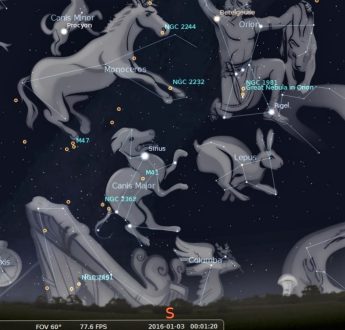This Week’s Sky at a Glance, 2023 Dec. 30 – 2024 Jan. 6
This Week’s Sky at a Glance, 2023 Dec. 30 – 2024 Jan. 6
Around midnight in the first week of January the brightest star in the night sky is due south, at its highest above the horizon. Astronomers would say it is transiting the meridian when it crosses the north-south line. Many 19th century observatories, including the one now called the William Brydone Jack Observatory at UNB Fredericton, would collaborate in timing the transits of stars to determine the longitudes of their observatories.
Sirius is called the Dog Star because it is part of the constellation Canis Major the Great Dog, one of Orion’s hunting companions. If you are unsure which star is Sirius, follow Orion’s Belt down to the left. The star is about twice the size of the Sun and 25 times more luminous, but that is not why it is the brightest. It is only 8.6 light years away, 82 trillion kilometres, and the nearest naked eye star for us in New Brunswick. The name means “scorcher” or “scintillating one” and it often twinkles wildly and colourfully, especially when it is lower in the sky. I like to observe it with binoculars or a telescope just to enjoy the light show. Look for the star cluster M41 about a binocular field below Sirius. With the Sun passing above Orion in summer, people once believed the hot days were due to extra heat from Sirius, hence the term “dog days of summer.”
This Week in the Solar System
Saturday’s sunrise in Moncton is at 8:01 and sunset will occur at 4:42, giving 8 hours, 41 minutes of daylight (8:03 and 4:50 in Saint John). Next Saturday the Sun will rise at 8:01 and set at 4:48, giving 8 hours, 47 minutes of daylight (8:03 and 4:56 in Saint John). After this week sunrise times will be earlier. On Tuesday Earth will be closest to the Sun for the year at a mere 147,100,632 kilometres.
The Moon reaches third quarter phase near midnight on Wednesday evening, an hour before it rises, and it sets shortly after noon Thursday. Saturn sets around 9 pm midweek so the earlier you observe it, the better. This Saturday telescope users might catch a double shadow transit of Jupiter’s moons. Europa’s shadow crosses the planet’s atmosphere between 6: 00 and 8:19 pm, while Ganymede’s takes a shorter route farther from the centre between 6:17 and 7:55. Venus is slowly moving sunward but it will remain in the morning sky throughout the winter. Mercury is stationary on Tuesday, rising 90 minutes before sunrise. Mars rises 45 minutes before the Sun but it is too faint to be seen in twilight. The occasionally prolific Quadrantid shower peaks Thursday morning, with meteors emanating from a radiant high in the east between BoÖtes and Draco where a former constellation called Quadrans Muralis depicted an astronomer’s wall quadrant.
The Saint John Astronomy Club meets in the Rockwood Park Interpretation Centre on January 6 at 7 pm.

